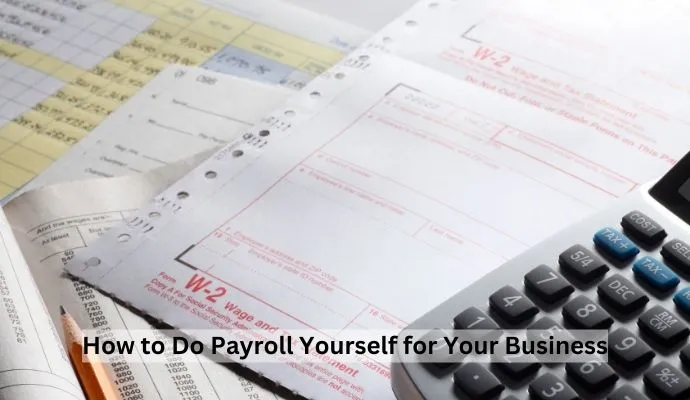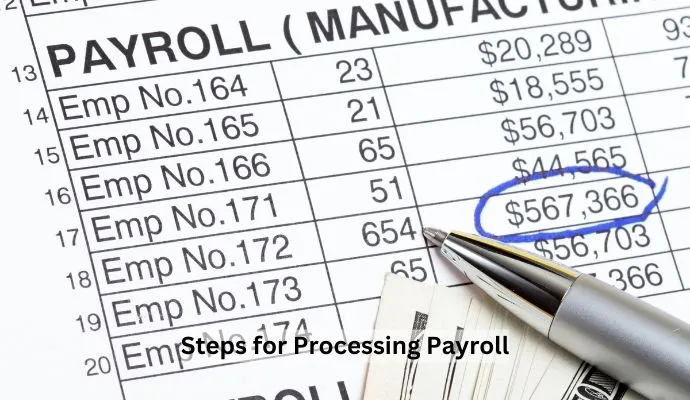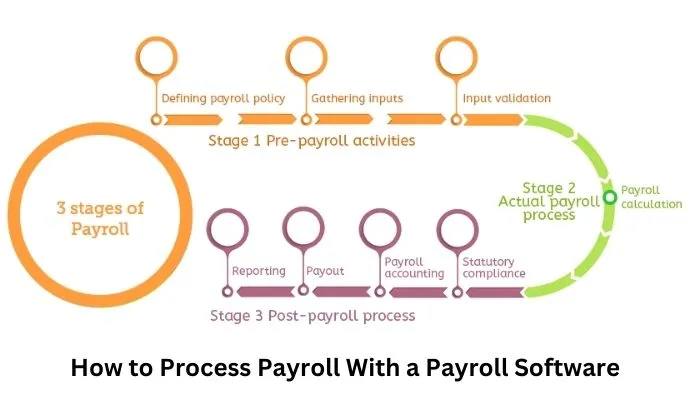How to Do Payroll Yourself for Your Business in 2025
Whether you want to learn how to create payroll templates or use an online platform to do all the payroll taxes, there are many ways to learn how to do payroll yourself. Surprisingly, many small businesses are unaware that creating their own payroll is possible.
You might wonder, "Can I do my own payroll for my small business?" The answer is yes, you can. Below, we'll discuss all the small business accounting required for payrolls so you can start creating your business' payroll today.
Can I Do My Own Payroll for My Small Business?
Handling payroll involves a lot of hectic work. You need to gather many numbers, such as the gross pay, overtime, deductions, taxes, employee details, and whatnot. This leads many owners to think they cannot create their payrolls.
Although handling payroll is time-consuming, you get faster at it the more you do it. With a few months of consistent practice, you can drastically reduce the time you need to make your payroll.
However, you must fulfill some requirements before dealing with employee taxes and withholding. The number one requirement includes an EIN, i.e., an employer identification number.
What this number does is that it gives you the legal security to do employee taxes and payroll. You must also provide federal and local authorities with some information regarding your business. We will discuss these details in more depth in the next section. Before then, we'll check out the different ways of handling payroll.
- Use Real Check Stub templates
- Make use of any other online template
- Pay for payroll software
- Hire professional services to do your payroll

Is It Okay to Process My Own Payroll for Small Business?
Now that you know that doing payroll is possible, you might be asking if it's okay to do payroll on your own. Let's take down this question with the help of the following example.
You run a business, let's say, a retail shop. You have five employees, all of whom require paychecks for paying their taxes and other purposes. Moreover, you have to deal with the legalities of paying taxes and employees. Now, can you work without doing the payroll on your own? Obviously not. You can get help from professionals, but they're often expensive and take money that you can put back into your business.
Furthermore, the payrolls of small businesses are often much less complicated than large-scale companies because there aren't too many transactions. So doing your payroll on your own is completely fine.
Plus, handling your own payroll might allow you to prevent payroll fraud. According to Forbes, payroll fraud occurs twice as many times in small businesses than it does in larger ones and often lasts for as long as 30 months. Taking a firm grip on your finances by learning how to do payroll for small businesses might help you secure your growing company against financial risk.
How to Process Payroll Yourself (Step-by-Step Guide)
Although you can do payroll yourself, we won't deny that the process is a little cumbersome. However, the steps only seem long if you are doing payroll for the first time. Once you accomplish a few of the initial tasks, doing payroll yourself will be straightforward. Why? Some tasks such as getting an EIN, and vital employee documents (W-2 and W-4 forms, Form I-9, IRS, etc.), must only be done once.
However, these tasks are crucial, and you cannot start processing payroll before handling them. The tasks are:
- Getting an EIN
- Obtaining the business ID
- Collecting important employee documents
- Choosing the proper payroll schedule
- Getting compensation insurance for workers
- Select the benefits you will provide employees with
- Open a bank account for payroll
Now let's discuss these steps in depth before we move on to processing payroll.
Getting an EIN
The Social Security Number serves as an individual's identification in the views of the government. For businesses, the equivalent number is known as a federal tax identification number or an employer identification number (EIN). To submit payroll taxes, your company will require one. It is free to apply for an EIN using Form SS-4, either online or by mail. Once accepted, it cannot be revoked and becomes permanent.
Obtaining the Business ID
The law also requires businesses to have an identification number provided by the state and municipal governments that claim income taxes. For specific information on acquiring one, consult with relevant agencies in your town. Generally speaking, you should first apply for a federal EIN, as some states might use it to identify your company/business.
Numerous states also demand a state unemployment identification number (UIN). This number needs to be dissimilar from the state income tax number. The use of this number will come out when you will need to pay taxes (UIN). Employers pay these taxes on behalf of their employees.
Collecting Important Employee Documents
When you pass the above steps, you need your employees to do some paperwork. This paperwork is a demand from the government. As for the vital documents, we will list them below.
- Form W-4
- Form I-9
- Withholding certificates (state)
All of the above forms and certificates are mostly filled by the employees on their first day, or a day before that, of their job. These are a requirement for processing payroll and also serve in many other legal dealings.
Moreover, there are other documents, such as form W-2, which you will prepare for your employees. For these forms, you need some information from your employees. This information includes the address of the current house/apartment of the employee and the SSN.
Choosing the Right Payroll Schedule
You have four options when it comes to selecting a good schedule for payroll. These options are:
- Monthly
- Twice a month
- Bi-weekly
- Weekly
However, you might not have much of an option. Some jurisdictions mandate specific pay intervals for certain job types, employers, or situations. For instance, employers in the manufacturing industry might impose a somewhat more regular schedule than the mentions of the general jurisdiction. In most cases, requirements also change depending on when you should pay the employees and when the pay period ends.
Getting Compensation Insurance for Workers
A state program called workers' compensation covers medical expenses and rehabilitation costs. In case an employee gets sick or hurt (physically) on the job, this program helps pay part of the employee's total income while they recover and their medical bills. Likewise, the family might be eligible for company benefits if an employee passes away because of a work-related accident.
Even if you only have a single employee, you need workers' compensation insurance in most states. You can buy insurance from the government, commercial insurers, or a combination of both.
When you file a claim, you must report it to your state. In addition, we would like to mention that this deduction will not be made from the payroll.
Select the Benefits You Will Provide Employees With
No matter your business' size, providing benefits to the employees gives a better image to your business. Not only does it increase your demand, but it also leaves a good impression on your current employees.
There are tens of benefits that you can offer to your employees. The most common are health insurance, paid time off (PTO), paid general holidays, education assistance, paid medical leave, and flexible spending accounts (FSAs) or health savings accounts (HSAs).
After the pandemic, many companies now also offer flexible schedules and remote work options. You can easily split your employee's work hours between remote and in-office days. One of the most effective payroll tips for small business owners is hammering these details in place before starting their payroll.
But not all the expenses of the benefits are cut from the business. You deduct a portion from the payroll. The cost you remove from the employee's wage will depend on which benefits they select and to what extent.
Open a Bank Account for Payroll
For the sole purpose of paying employees, countless businesses opt to establish separate bank accounts from their main business accounts. In case you want to do the same, ensure that you only use this account to pay workers and file taxes. The benefit of this step is that it will allow you to document your transactions (payroll) more accurately and is generally less troublesome.
Now that you know the initial steps, let's move forward to the steps for processing payroll.
Steps for Processing Payroll

- Calculation of working hours and gross wage
- Marking the deductions for payroll
- Paying the employees after calculating the net pay
- Filing/making the tax reports
- Making a document for keeping payroll records
Although there are just five steps, each has a lot of detail and needs careful attention. The following section will give you an idea of the depth of these five steps.
Step 1: Calculation of Working Hours and Gross Wage
The first step to processing payroll on your own involves the calculation of the sum of the hours your employee works. Punch clocks, spreadsheets, and paper time sheets are perfect examples of keeping a record of this data.
Then you have to determine the gross wage of each employee. For this purpose, you need to separately calculate the result by multiplying the pay rate of the specific employee with the number of hours they worked for you. Remember to record tips and overtime hours your nonexempt workers receive.
Your workweeks can start and finish whenever you like, but these workweeks require you to mention seven 24-hour blocks. Furthermore, remember that different states vary in their rules regarding when overtime salary is due. For instance, there is one state that requires you to pay your employees overtime wages after they have completed eight hours.
Step 2: Marking the Deductions for Payroll
After calculating the gross wages, you need to move on to making the payroll deductions. There are three types of deductions when it comes to payroll. These are:
- Pre-tax deductions
- Statutory deductions
- Post-tax deductions
Pre-tax deductions include the amount you need to deduct for health benefits. These can also include 401(k) retirement plans.
Next up are the statutory deductions. This is where most of the tax work will come from. Here, you'll need to calculate the FICA, FUTA, state, federal, social security, and medical taxes. In addition, each state has its taxes, which you must also calculate in this step.
Lastly, you need to execute post-tax deductions. These include IRA plans, court-ordered wage garnishments, and some union taxes. So only the employees with these sections will be subject to post-tax deductions. You can also use a salary paycheck calculator for this purpose.
Step 3: Paying the Employees After Calculating Net Pay
When you calculate the payroll deductions, the remaining amount is the net pay of each employee. There are many options for paying your employees. However, make sure that the option you select falls under state laws.
In the case of electronic delivery, ensure you know all the requirements in your state. Many states ask employers to provide a pay statement when they pay their employees.
Step 4: Filing/Making Tax Reports
You might think that the tax game is over. But here comes the tricky part. When you run a business, one of the large requirements is filing taxes with the federal government and some local agencies. Form 941 is there to help you with the FICA and income taxes.
For FUTA taxes, you should consider filing form 940. Lastly, the state unemployment tax is something you need to file separately. The guidelines and steps for filing this tax vary in your state.
Step 5: Make a Document for Keeping Payroll Records
You might name this step bookkeeping or something similar, but this step will save you plenty of hard work in the future. You can make a separate document for each employee. This document must include the following few pieces of information:
- Name of the employee
- SSN
- House address
- Workweek details
- Working hours for the day and workweek
- Method of paying employee net pay
- Hourly pay rate
- Overtime pay
- Payroll deductions
- Gross wage
- Net pay
- Form W-4
- Tax deductions
- Payment date
You must keep these records for at least four to five years. Other information is to be saved according to the requirements of your local authorities.
Pros and Cons of Doing Your Own Payroll
Doing payroll on your own is a great initiative. However, like any other thing, there are pros and cons of doing your own payroll.
The pros are:
- No third-party involvement
- All calculations are done by you
- No false information will be a part of the payroll
- Changes in work hours will be recorded easily
Cons:
- Time-consuming process
- Might end up filing the wrong information due to stress
How to Process Payroll With a Payroll Software (Step-by-Step Guide)

Apart from doing the payroll yourself, you can get help from payroll software. You must pay some set amount to get their services. There are many payroll software, and you can use these top 10 payroll solutions. Now, let's discuss payroll processing via payroll software.
- Select your payroll software
- Set up a policy according to your business for payroll
- List all the employee information
- Mention the benefits you provide your employees
- List your preferable mode of paying salary
- Provide information regarding taxes
- Choose the plan that suits you the best
Pros and Cons of Doing Payroll With Software
Pros of doing payroll with the software are:
- Accurate calculations
- On-time payments
- Less stressful
- Calculation of extra expenses becomes easy
- Automatic printing of certain employee forms
Cons of doing payroll with the software are:
- Expenses might not suit small businesses
- Security issues
- Fraud reports
Should You Automate Payroll?
If you are a tiny business, we recommend you automate payroll. There are many advantages to it, even for other small-scale businesses. Firstly, it saves you a bunch of time. Secondly, your employees won't face any delay in receiving their pay. So, we do recommend you automate payroll.
When Should You Delegate Payroll to a Service Provider?
You can't do payroll on your own forever. There comes a time when your business expands, and there are other things that require your attention. In such cases, you must delegate payroll to a service provider. It will save you a lot of time and stress.
Is Payroll Service Worth It?
Payroll service is worth it only if you make the right choice. In case you select the wrong service provider, it might be the worst business decision you ever make.
Common Mistakes to Avoid During Your Own Payroll
Since processing payroll is a hefty task, there are some mistakes people make. To help you avoid them, we are listing them here.
- Wrong worker status
- Not updating the W-2, W-4 forms
- Inaccurate tax deductions
- Extra withholding of taxes
- Wrong payment dates (for taxes and net pay)
Frequently Asked Questions (FAQs)
Can I do my own payroll for free?
Yes, you can do your payroll for free. If you're wondering "How can I do payroll myself for free," read the above guide.
Can I do payroll manually?
Yes, you can. Learning how to do payroll manually will take some time. However, it is a valid option.
How to set up payroll for 1 employee?
Setting up payroll for one employee is the same as setting up payroll for a small business. The steps are the same. However, it will take you less time to do so.
How to do payroll in Excel?
To do payroll in excel, you first need to select the template which matches your requirements. The steps after this are the same. You need to enter the deductions and finally move on to paying your employees.
Final Thoughts on Running Payroll Yourself
Doing your own payroll is something we recommend and support to every extent. It'sIt's a little time-consuming process. But since the calculations will be in your hands, there is not much you will have to fear. The steps are numerous but easy. So select whichever method suits you the best and make sure to avoid the common mistakes.
Kristen Larson is a payroll specialist with over 10 years of experience in the field. She received her Bachelor's degree in Business Administration from the University of Minnesota. Kristen has dedicated her career to helping organizations effectively manage their payroll processes with Real Check Stubs.

